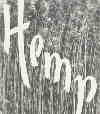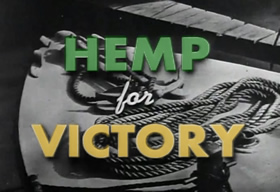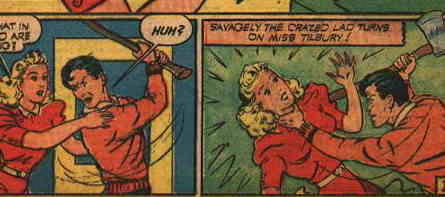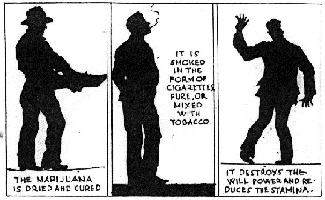
|
 DURING THE SECOND WORLD WAR |

|
|---|

|
 |
|---|
INDUSTRIAL HEMP
As per the Grand Forks Herald - Feb. 16, 1917p8:
Note, probably some transcriber errors have occurred
GrandForksHerald1917-02-16p8
American Hemp -- A PROFITABLE CROP—AND A WEED FIGHTER.
(By J. G. Haney, Agri. Exten. Dept., International Harvester Co.)
Hemp adds another crop, and has proven more reliable than all other crops, excepting alfalfa and sweet clover. More than $80,000,000 leaves the United States each year for fibre used In binder twine. We can grow hemp at a profit and keep this money at home. Binder Twine is high because the Sisal Monopoly of Yucatan, Mexico, controls the output and has boosted the price, and will put it higher unless we grow hemp and "bust" them.
The United States Senate Committee reported the following facts:
"American farmers should make every effort to find a suitable substitute for sisal which can be grown in the United States in order that they may defy the foreign monopoly.
"There is active competition and no monopoly or combination in the sale of binder twine.
"The price of twine is based on the cost of the raw material. The manufacturers of twine have not made an exorbitant profit.
"The Yucatan Sisal Market was competitive until the Reguladora (Sisal Trust) obtained control. Smaller manufacturers and state prisons purchased their raw material as cheaply as the Plymouth Cordage Co., and the International Harvester company.
Fibre Crops.
The two fibre producing plants most promising for cultivation in central United States, and most certain to yield satisfactory profits, are hemp and flax. The oldest cultivated fibre plant, one for which the conditions in the United States are as favorable as anywhere in the world, and which properly handled improves and cleans the land and yields one of the strongest and most durable fibres, is hemp.
Hemp for Binder Twine.
American hemp has proven the most satisfactory of all the fibres produced in the United States for the: manufacture of binder twine. At the present time there is special interest in the production of fibre, for this purpose, because of the fact that the sisal fibre from which most of our binder twine has been made for the past few years, has risen in price from 5 to 11 cents, and there is every prospect of the price being forced still higher.
The United States Senate Committee, appointed to investigate this subject, recommends as one solution, that the American farmer grow fibre from which twine can be made. (A summary of their report is enclosed, or may be had for the asking.)
Hemp in the Northwest.
Hemp is not a new crop, even in this section, for it has been grown experimentally for more than ten years In Wisconsin, and has increased to over 5,000 acres in 1916. In Minnesota it has been grown at the Northwest Experiment Station at Crookston, with great success. Sixty acres on the I. H. C. Demonstration Farms at Grand Forks, North Dakota, and Aberdeen. South Dakota, made a most satisfactory yield in 1916. There seems absolutely no question as to the production of this crop, when properly seeded on our good heavy soils.
Growing Hemp.
Hemp is an annual plant. That is, it must be seeded every year, and in this region will very seldom mature seed before frost. It is planted the same as small grain, and makes a remarkably rapid growth. The plants while growing look very much like the weed known as "King Head," but belongs to the mulberry and osage orange family.
Hemp Grows Fast.
A good growth of hemp is 6 feet, although much of ours on the farms last year grew a great deal higher. This Indicates that conditions here must be favorable or such a growth would not be attained.
It Is Important that the hemp be planted at a time when the soil is in condition for promoting rapid growth, and the better the soil on which the crop is planted, the better the growth and the higher the production of fibre.
Hemp Similar to Corn.
Our observations are that hemp should have practically the same kind of soil, preparation and weather for successful growth, as is necessary for corn, in other words, any soil that is satisfactory for corn would be suitable for hemp.
Summer Fallow, Corn or Potato Hand Best.
Especially if the land is quite weedy, it would be desirable to have land that was in the best possible shape, so that the hemp would make a quick growth, and so great ahead of the weeds. It produces such a heavy growth, that, after it gets started, there would be no chance for them to ever get light enough to make any growth during the summer.
Hemp Will Kill Quack Grass and Other Weeds.
There is absolutely no question but that hemp planted on properly prepared land, and having favorable weather for growth, will absolutely kill out all kinds of weeds. It may be necessary, under some conditions, to grow the crops twice in succession to fully accomplish this, but there Is no crop that is equal to hemp for this purpose.
Amount of Seed to Sow.
Our experience indicates that three pecks of seed should be sown per acre, with a grain drill, the same as small grain. It would be desired, when possible, to have a drill which plants in rows as close as possible. A 4-inch drill would be preferable to a 6 or 7-inch, so that the plants would be evenly distributed. Such planting produces better fibre and also controls the weeds to a greater extent.
Thoroughly Cultivate Before Seeding.
It is essential that the ground be in a thorough state of cultivation at the time of planting, especially If there are weeds to be overcome. The hemp will make a correspondingly greater growth if this precaution is taken. The spring tooth harrow or disc should be used, and the land thoroughly harrowed just before seeding. The seed should be planted at an even depth so that all the plants will get started at the same time. The seed should be put in as shallow as possible and yet be in moist soil. The seed starts very quickly and the plants grow more rapidly than any other crop we know of.
Hemp Seed.
Hemp seed production is entirely different from the production of hemp fibre, and doubtless will be continued to more southern sections, where the seasons are longer. At the present time, practically all of the seed produced in the United States comes from Kentucky.
For seed, hemp is planted much the same as corn given cultivation and harvested and threshed by hand, There is no doubt, however, but that as the demand for seed increases the handling of this will be accomplished by machinery.
Harvesting Hemp.
Hemp for fiber is cut when in full bloom, and must be spread on the ground to thoroughly cure. However, our observations last year Indicated that it will be possible to allow this hemp to cure standing. Machinery developed for cutting the hemp and spreading it and later picking it up and binding it, so that it can be stacked similar to small grain. In Wisconsin all the hemp is cut, cured, bound and stacked, and then the breaking, or extracting of the fibre is done the spring following.
Hemp Not Damaged by Light Frosts.
Hemp is very little damaged by light frosts, either in spring or fall, and if the hemp should not be gathered up and stacked before the snow, it would really be in better shape the next spring, after the snow went off, than if stacked. Young hemp plants will stand more frost than oats and not be damaged.
Probable Income from Hemp.
The yield of hemp fibre ranges at about 1,000 pounds per acre, although in Wisconsin it has gone up as high as 2,000 pounds. The expense of growing hemp. Including all items of rent of land, labor, use of machinery, breaking and baling the fibre, will range from $25,000 to $35.00 per acre. The crop at the present time is selling at from 10 to 12 1-2 cents per pound. This, it will readily be seen, leaves a very large margin of profit.
Production to Be Increased.
The satisfactory showing made by the hemp grown on our farms last season, and the great improvement recently made in the machinery for handling this crop, has warrented our encouraging the growing of this crop on a much larger scale. A large amount of seed was contracted for in Kentucky last year, and is now available for distribution in this region.
Contracting for Growing Hemp.
We are contracting for the growing of this hemp under certain conditions. As we are taking the full responsibility of furnishing seed, machinery and paying for the work of growing and handling this crop, it will be desirable to have at least 200 acres within a radius of three miles, as machinery will have to be sent to these different centers for cutting and breaking the crop, and it would not be desirable to move this around to any great extent.
Literature on Hemp.
There is very little literature available on the subject of hemp culture, but "Hemp," 1913 year Book Separate No. 628 by Lyster H. Dewey of the Fibre Investigation Bureau of the Department of Agriculture, Washington, D. C, is a very exhaustive treatise on the subject.
Extracts from the Above Mentioned Bulletin.
Soils Suited to Hemp —Hemp requires for the best development of the plant, and also for the production of a large quantity and good quality of fibre, a rich, moist, soil, having good natural drainage, yet not subject to severe drought at any time during the growing season. A clay loam of rather loose texture and containing a plentiful supply of decaying vegetable matter or an alluvial deposit alkaline and not acid in reaction should be chosen for this crop. (Dakotas and Minnesota soils O. K.)
Soils to be Avoided —Hemp will not grow well on stiff, impervious clay soils, or on light sandy or gravelly soils. It will not grow well on soils that in their wild state are overgrown with either sedges or huckleberry bushes. These plants usually indicate acid soils, it will make only a poor growth on soils with a hardpan near the surface or in fields worn out by long cultivations. Clay loams or heavier soils give heavier yields of strong, but coarser fibre than are obtained on sandy loams and lighter soils.
Effect on Hemp on the Land — Hemp cultivated for the production of fibre, cut before the seeds are formed, and retted, (cured) on the land where It has grown, tends to Improve rather than injure the soil. It Improves its physical condition, destroys weeds, and does not exhaust Its fertility.
Physical Condition —Hemp loosens the soli and makes it more mellow. The soil is shaded by hemp more than by any other crop. The foliage at the top of the growing plants makes a dense shade, and in addition all the leaves below the top fall off, forming a mulch on the ground, so that the surface of the soil remains moist and in better condition for the action of soil bacteria. The rather coarse taproots, penetrating deeply and bringing up plant food from the subsoil, decay quickly after the crop is harvested and tend to loosen the soil more than do the fibrous roots of wheat, oats and similar broadcast crops. Land is more easily plowed after hemp than after corn or small grain.
Hemp Destroys Weeds —Very few of the common weeds troublesome on the farm can survive the dense shade of a good crop of hemp. If the hemp makes a short weak growth, owing to unsuitable soil, drought, or other causes, it will have little effect in checking the growth of weeds, but a good, dense crop, 6 feet or more in height, will leave the ground practically free from weeds at harvest time. In Wisconsin, Canada Thistle has been completely killed and quack grass severely checked, by one crop of hemp- In one 4-acre field in Vernon county, Wisconsin, where Canada Thistles were very thick, fully 95 per cent of the thistles were killed where the hemp attained a height of 5 feet or more, but on a dry, gravelly hillside in this same field, where it grew only 2 or 8 feet high, the thistles were checked no more than they would have been in a grain crop. Some vines, like the wild morning glory and bindweed climb up the hemp stalks and secure light enough for growth, but low growing weeds cannot live in a hemp field.
Logan Republican (Utah) June 25, 1918p7
Difficulties in Increasing Supplies of Hemp
The cutting off of supplies of hemp from Russia the Increasing difficulties in securing hemp from Italy, and also the difficulty In obtaining Jute from India, makes it imperative that more hemp be produced In the United States according to U. S. Department of Agriculture" officials.
Owing to low prices for hemp compared with prices of tobacco and corn at the time of planting, the hemparea in Kentucky is less than 8,000 acres compared with 18,000 acres last year. But In Wisconsin, where the hemp fibre Is all prepared by machinery Instead of by hand, as In Kentucky, the area is 8,000 acres compared with 7000, last year. There has been a reduction also in the hemp seed planted In the Kentucky River Valle, threatening a shortage of hemp seed next spring. The Wisconsin hemp growers are having 100 acres of seed hemp grown in Missouri.
WANT TO KNOW MORE:
=====================
Due to space / download time considerations, only selected materials are displayed. If you would like to obtain more information, feel free to contact the museum. All our material is available (at cost) on CD-Rom format.
CONTACT PAGE
 BACK TO SECTION III |